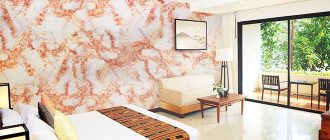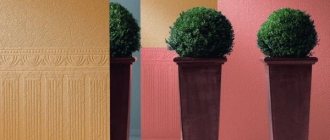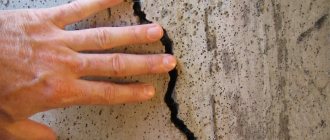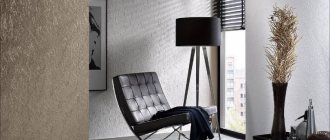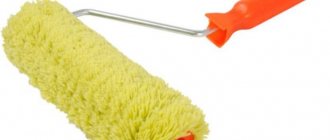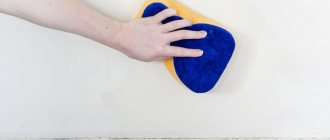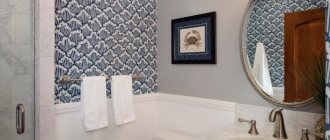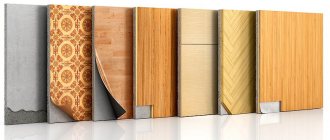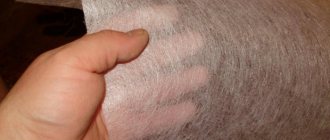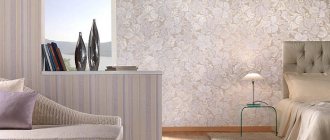When exactly should you choose wallpaper?
When you are faced with a choice between wallpaper and painting the walls, you should give preference to the first option if:
- you are making repairs in a “dry” area (children’s room, bedroom, living room); you plan to focus on complex design (prints, patterns);
- Do you want to hide wall defects without complicated preparation, long leveling of walls with plaster and putty.
Wallpapering is the right decision if you are doing the renovation yourself. You won’t have to spend a long time selecting or inventing a shade and texture, and even an untrained person can handle the finishing process.
When choosing such a finishing material, pay attention to its appearance. Different wallpapers cost, look, serve and apply differently:
- Paper wallpaper. One of the advantages is that they do not emit harmful substances and allow air to pass through. But they quickly become unusable.
- Non-woven. Eco-friendly, breathable, easy to apply and care for. They do not tolerate high humidity.
- Vinyl. Dense, camouflaging, waterproof, non-fading. Hides all small and medium-sized irregularities. Dangerous when heated; excessive heat releases toxic substances.
The type of wallpaper is especially important when you decide what the surface of the wall will be - smooth or textured, plain or tacky. In comparison with coloring, some will win, others will lose.
Paint: pros and cons
Paint or wallpaper is a dilemma solved by comparing the pros and cons of each type. Therefore, the types of paints and varnishes for interior work will be described below.
Water-based preparations
They are characterized by quick drying and ease of application. There are subtypes that have a relief texture that can cover up minor imperfections in the base. Exposure to ultraviolet rays causes color fading.
They are characterized by quick drying and ease of application.
Water-dispersed
A coating that is resistant to water, mechanical stress and breathable is obtained. Suitable for rooms with high humidity. The product is produced in two colors - white, black; dyes are used to obtain the required shade. If the room is cold, the layer will begin to deform.
A coating that is resistant to water, mechanical stress and breathable is obtained.
Acrylic
The film-like coating is durable and elastic. Moisture-resistant properties and resistance to ultraviolet radiation make the composition popular. But the price is expensive.
The film-like coating is durable and elastic.
Latex
The layer will repel moisture and will be able to cover some surface defects. The drying process does not take much time and is easy to apply. Can be used for textured and smooth substrates.
The layer will repel moisture and will be able to cover some surface defects.
Silicone
The degree of coverage is the highest compared to other types, so they can cover up flaws. Moisture resistant, washable.
The degree of coverage is the highest compared to other types, so they can cover up flaws.
Benefits of paints
The preparatory stage requires priming and the application of antiseptic agents, which helps to eliminate biological formations in the future. Paints are easy to update and correct flaws. It is possible to wash the layer; pets are passive to such finishing.
Paints are easy to update and correct flaws.
Flaws
Carrying out such repairs requires special skills; professionals charge a lot of money for such a service. Strong mechanical shocks are dangerous for the coating; the paint may peel off. Decorative paints with a textured structure are expensive.
Carrying out such repairs requires special skills; professionals charge a lot of money for such a service.
When is the best time to choose paint?
It is permissible to paint the walls in any room: many modern interiors can do without wallpaper at all, without losing the feeling of coziness. In some cases, this finishing option is really the most suitable:
- Search for “that same” shade. When you need a certain tone of green with a drop of blue and brown, looking for wallpaper is not an option. It’s easier to find it in a huge palette of ready-made paint cans or order computer tinting. Moreover, it is possible to choose not only a complex abstract tone, but also to repeat the exact color “to match something” - for example, to match the same wallpaper with which the accent wall is decorated.
- Complex grounds. We are talking about log walls, lining, drywall and other surfaces of the house that there is no desire to level. It will be more profitable to replace the color using paint, a brush, or a roller.
- Possibility of quick rework. Preparing walls for painting is a complex and expensive process. But after it, it will take only a few hours to completely update the color of the walls. This is convenient if you like permutations and are open to fresh ideas.
- The basis for the artistic concept. The paint on the wall does not have to be a single color. Buy special stencils, create them yourself, or order decor from an artist to decorate the surface the way you want. After all, even among ready-made prints on photo wallpapers, it is not always possible to find the exact same thing.
Comparison of labor intensity of installation work
Despite the result, you need to evaluate your capabilities. Even if you do the coating yourself, you need to know how much work will need to be done. When hiring specialists, you will have a clear idea of what is required for the job and what expenses to prepare for.
Preparatory activities
If you are installing non-foamed vinyl, you will have to prepare the walls. Remove the old coating, eliminate unevenness, and properly “heal” cracks. There should be no bulges or dents left.
Significant defects are smoothed out with plaster, minor irregularities are eliminated with putty.
Apply the primer in two layers, leaving each to dry completely. Without a primer composition, it is impossible to obtain the required level of adhesion of substances, which means that the fresh cladding will quickly fall off.
If the finishing is in the bathroom or kitchen, or in a room exposed to fungus or mold, use a primer with an antiseptic in the composition. Mandatory treatment with antiseptic agents is carried out before priming if the wall has been washed of mold.
Installation technology
Any type of paint can be applied with several tools - brush, roller, spray. The choice depends on the thickness of the layer and the end goal.
Wallpapers come in a wide variety. Lightweight canvases are coated with glue and glued to dry walls, or vice versa - the main surface is covered with a solution and a dry sheet is glued.
Products of medium or heavy weight are coated with the solution and the base is coated.
Paper wallpaper is glued immediately after applying the glue, otherwise it will become limp. Vinyl or non-woven fabric should lie down for a while and become saturated with adhesive.
Self-adhesive sheets are the easiest to install - just gradually remove the protective film from the back side and glue the sheet.
As an alternative, you can stick paintable wallpaper and paint it. The result will be partial leveling of the surface, a monochromatic coating, and a relief pattern. Then you don’t have to choose just one thing, while still achieving high decorativeness.
What's more expensive?
It’s hard to say which wall decoration, wallpaper or painting will cost a pretty penny. After all, construction markets offer an assortment to suit every taste and budget.
- The most economical option is paper wallpaper and water-based emulsion. They have an equally short service life (up to 3-5 years); both types of coating cannot be maintained due to fear of water.
- Middle price segment - non-woven fabrics, acrylic and latex mixtures. They last up to 10 years and are easier to maintain - but not all coatings can withstand washing.
- The most expensive options are vinyl canvas with silicone added to the paint composition. They are dense, mask surface imperfections, and can be washed with water.
In general, the cost of the paint or wallpaper itself, as well as the additional costs for applying it, are approximately the same.
Comparative characteristics
So, what is better: wallpapering or painting the walls? Let's approach this issue from all sides, comparing possible costs, visual perception, environmental friendliness, practicality and operation.
Expenses
What is cheaper: painting the walls or hanging wallpaper? If we take into account that hired workers will not be used, then everything depends on the cost of the materials themselves.
Their prices are very flexible. There are expensive and cheap samples in both cases, and the balance between cost and quality is always fairly well maintained.
So, for complete finishing of the same area, approximately the same budget will be required. There is no clear leader in this category.
Visual perception
This is where things get much more complicated:
- Paints and varnishes can recreate almost any shade, which will become an excellent backdrop for any interior. But only a professional artist or painter can achieve any complex compositions or ornaments.
Complex composition made by a specialist
Advice: if you want to achieve greater variety in the color palette, it is recommended to use water-dispersed compositions. Because, thanks to their special properties, they mix wonderfully, forming new and more unique colors.
Assortment of colors available as a result of tinting
- Wallpaper can boast not only a colossal color spectrum, but also patterns of any complexity and even different textures, which brings additional possibilities when fulfilling the design intent. And that is not all. In addition to the visual effect, this finish can have a different effect on the senses of touch, as it can be made of paper, non-woven fabric, fabric, bamboo, wood and even metal.
Which is more practical?
Painting walls has one big drawback - the surface literally attracts dust. But this is offset by simplified maintenance - just wash the walls with a damp cloth during cleaning.
On a plain base, stains and dirt are not only visible, they will be conspicuous - so for this finishing option, choose washable wallpaper and compositions. Especially relevant for the hallway, nursery, kitchen.
Textured wallpaper with small patterns makes minor stains visually almost invisible. This is an undeniable advantage of decorative canvases.
Life time
In the section “What is More Expensive” we have already said that the higher the cost, the longer such finishing will last - this applies to both wallpaper and dyes.
Paper will last 3-5 years, non-woven - 5-8, vinyl - about 10, dyeing doubles the life of the canvas.
Even the simplest water-based emulsion is designed to last about 10 years, acrylic - 10-20, silicone composition lasts on the walls for 20 years or more. The most short-lived latex painting is 5-10 years.
Burnout
What is more practical than wallpaper or painting a wall in a sunny room is difficult to answer. If you save money, then both categories are afraid of ultraviolet radiation - they will fade and lose their original luster.
Tip: Painting or pasting with more expensive modern materials guarantees color preservation for the entire service life.
Resistance to mechanical stress
Sharp objects, claws of pets, awkward movements of family members are fatal for any type of wallpaper. They are easily scratched and deteriorated, and the entire canvas will have to be replaced due to damage.
The painting is more stable and reliable; after 48-72 hours after application, the composition is completely covered with a protective film - so it will not be easy to harm even your favorite animal with sharp claws. And if this does happen and the coating is damaged, it’s enough to putty and touch up the chipped area.
Comparison of wallpaper and painting
In order to objectively make a decision between these two finishing materials, a number of criteria are studied to determine the possibility of using each for certain working conditions.
In order to objectively make a decision between these two finishing materials, a number of criteria are studied.
What is more expensive
A comparative analysis of the cost of materials showed that paints are cheaper compared to wallpaper. We are talking only about the means themselves, without taking into account the costs of other tools and materials required for the process.
A comparative analysis of the cost of materials showed that paints are cheaper compared to wallpaper.
Cost of work
If you need to involve specialists in repairs, then the complexity of preparing the surface for painting is taken into account; here you need to get a perfectly leveled base. Therefore, services will cost more, and painting itself is more expensive compared to gluing canvases.
Services will cost more, and painting itself is more expensive compared to gluing canvases.
Complexities of technology
The degree of complexity of the technology for gluing and painting a single-color coating is similar. But gluing wallpaper with patterns is somewhat more difficult, which means it will be more difficult to glue the wallpaper.
Gluing wallpaper with patterns is somewhat more difficult; accordingly, gluing the wallpaper will be more difficult.
Wall surface requirements
As mentioned earlier, paint can be applied to a leveled surface; it will highlight any flaws. Wallpaper can cover some of the defects.
The paint can be applied to a leveled surface; it will highlight any imperfections.
Difficulty of removal
Removing old material is difficult in both cases. But the elimination of the painted layer is carried out with special means, and requires more time and effort. In this case, the colors lose.
Elimination of the painted layer is carried out with special means and requires more time and effort.
Fire resistance
Silicate paints and glass wallpaper are considered non-flammable. Other types of finishing materials are equivalent.
Silicate paints and glass wallpaper are considered non-flammable.
Resistant to fading
Any finishing materials can withstand exposure to ultraviolet radiation if they are of high quality. Budget types of wallpaper and paints are not resistant to such effects.
Any finishing materials can withstand exposure to ultraviolet radiation if they are of high quality.
Resistance to mechanical stress
Wallpaper fabrics are easy to tear and scratch. And the paint layer is not easily subjected to mechanical stress. The colors win here.
The paint layer is not easily subjected to mechanical stress.
Life time
Vinyl and glass wallpaper are durable wallpapers; paint and varnish materials all last a long time.
Vinyl and glass wallpaper are durable wallpapers.
Waterproof
The resistance to water of coloring agents is higher; all types can withstand a similar load. Wallpaper does not have this property; only vinyl wallpaper is glued in a room with high humidity.
The resistance to water of coloring agents is higher; all types can withstand a similar load.
Design
The design is chosen from the individual preferences of the owners, and depends on the taste of the owner. For this reason, comparison is not possible.
The design is chosen from the individual preferences of the owners, and depends on the taste of the owner.
Ecological cleanliness
For interior work, safe materials of both types are created. However, wallpaper based on vinyl, under the influence of a number of unforeseen factors, can release toxic substances.
For interior work, safe materials of both types are created.
Thermal and sound insulation
Wallpaper material can slightly reduce the sound transmission of walls. Coloring compounds do not have this characteristic.
Wallpaper material can slightly reduce the sound transmission of walls.
Which is more practical?
The paper type of wallpaper is not practical. Vinyl and non-woven ones attract dirt less, but washing them is difficult. The painted layer can be washed, although it tends to attract dirt. In terms of practicality, paints are considered the best.
In terms of practicality, paints are considered the best.
Which material is cheaper to install?
Repairs of any complexity can be done independently, or you can entrust them to professionals.
Wallpapering is easier: remove large holes or bulges, prime, glue. A professional team will certainly do everything efficiently: the seams will be invisible, the pattern will be adjusted. But it will require about 120 rubles per square meter for these actions (prices depend on the city of residence).
The painting itself does not require any special skills, but before doing this, the walls need to be made perfectly smooth. This is labor intensive and can create many problems. In order not to be disappointed with the result, contact a specialist for quality. The price of preparation for 1m2 starts from 400 rubles, painting - 140 rubles.
WALLPAPERS - PROS
Preparing the walls does not require much effort
To hang wallpaper, you will not need to spend a lot of time preparing the walls and ensuring that they are perfectly smooth and free of cracks, chips, holes and other flaws.
Hide wall defects
In continuation of the above, it is worth saying that if your walls are far from ideal, have unevenness, cracks, certain defects and damage, then wallpaper will be the best option. They will hide all imperfections, and you will not have to spend a lot of money and effort on leveling the surface.
You can glue it yourself
To hang wallpaper, you do not need to hire a team of professionals, have any special skills or purchase special tools. This is not the most difficult type of repair work. If you are careful and diligent, you can do everything yourself.
You may find it useful
Wallpaper has the potential to make a room more stylish, giving it more depth and warmth. All other things being equal, it is quite difficult to achieve the same effect with paint.
Huge selection
Wallpaper comes in an endless variety of colors, shades, patterns, textures and designs. The market offers options from various materials - classic paper, popular vinyl, textured non-woven. There is a large selection of effects, such as glitter, mother-of-pearl, embossed and 3D wallpaper, suede, metallic shimmer, silk and so on. This is a whole world where everyone will find something that suits their taste preferences and wallet size.
Unlimited flight of design ideas
Wallpaper is the most customizable option, giving you the widest range of options to achieve exactly what you want. They allow you to turn a wall into a window with a panoramic view of a modern city, a waterfall, a zoo, a brick wall or an art gallery - anything. With their help, you can make your wildest dreams come true of any landscapes that you would like to look at every day. In other words, you can transform your home into a stylish space that expresses your personality just by wallpapering your walls.
What is more difficult to remove from the walls?
When deciding to wallpaper or paint your walls, consider the following renovation: You will have to remove the old coating before applying the new one.
The easiest way to get rid of wallpaper is to wet paper wallpaper, leave it for 5-10 minutes and remove it without any residue. Non-woven and vinyl come in two types: some can be easily removed without a trace, others can also be easily removed, but if dismantling is carried out correctly, they leave a thin base - the following canvases can be glued onto it without preparation.
With painting it’s different - if you plan to repaint, you don’t have to remove the high-quality coating at all. After you wash and prepare the wall, apply a new color, a new layer. If the paint starts to come off and cracks appear, it won’t work without dismantling. You'll have to try hard to remove it. For this purpose, solvents, sandpapers, construction tools and other technologies are used. The process is very long and labor-intensive.
Pros of painting
Whatever option is chosen, it is necessary to carry out quality repairs. Whether it will be painting the walls or wallpaper, it all depends on your desire. Paint is often used. Various materials are used for this. Special, reliable, odorless paint and varnish mixtures are quite popular at the moment. The advantages of painting include:
- In preparation for such work, according to technology, it is necessary to treat the room. Antiseptics and primers are applied to the walls to eliminate mold and other microorganisms.
- If cosmetic repairs are necessary, you do not need to paint the entire wall, you can only update a separate area. It is done quickly and is cheap.
- Painted walls can then be washed.
- Pets will not be able to spoil the appearance of the surface.
- There are many types of paints available to transform various interiors.
Puttying walls for painting, the price of which depends on the chosen material, is a mandatory step. To level the surface, mixtures are used for 120-480 rubles per package. Gypsum mixtures cost between 280-420 rubles per 18 kg. For acrylic putty compounds you will have to pay 860-1820 rubles per 10 kg. The price depends on the company. This, of course, requires additional material costs, but in the end you acquire a high-quality foundation that will facilitate the work during the next repair.
Which is more environmentally friendly?
When creating both finishing options, manufacturers use environmentally friendly components and conduct more than one study before launching the line. Therefore, a purchased can of dye or a roll of wallpaper will not harm the health of children and adults.
The only exception is vinyl wallpaper; at high temperatures (fire) they release harmful substances into the air.
Pros and cons of wallpaper
Wallpaper is easy to glue, you can carry out repairs yourself. No careful surface preparation is required. They are environmentally friendly, with the exception of the vinyl type. Modern canvases can create a textured coating on the surface, expanding the range of styles.
Both wallpaper and paint can be applied to drywall, but the surface must be prepared to prevent it from being destroyed. Disadvantages include difficulty in washing and weakness to mechanical stress.
Wallpaper is easy to glue, you can carry out repairs yourself.
Variety of designs
You can evaluate the appearance from different angles:
- Paints have a larger selection of colors and shades; in many stores, the function of computer tinting of a white base is available - therefore, in a one-color comparison, paint and varnish materials are in the lead.
- Wallpaper has a lot of ready-made design options - small repeating print, large repeat, ready-made paintings. All you have to do is choose the one that suits you and stick it on the wall.
- Using paint and a stencil, you can easily create your own pattern, and your artistic talent will allow you to create a real work of art. Custom design is fashionable.
Positive and negative features of wallpaper
At first, rolls were made from paper of different densities, differing in composition. The main parameter was one thing - they are completely paper.
As production technologies developed, a large selection of shades and additives appeared that gave new properties to the original raw materials. Additionally, the choice of designs has expanded, relief patterns and silk-screen printing have appeared, which bring more benefits than planned.
From paper
The most environmentally friendly option is paper sheets that allow air flow to pass through and are classified as “breathable”. They are very light, which allows them to cover any thin walls or non-durable structures.
This option is not reliable. The surface instantly deteriorates from exposure to moisture, paint, grease, is easily scraped, and traces may remain from the slightest physical contact.
With non-woven fabric
A more reliable method of wall covering is non-woven wallpaper, created on the basis of non-woven material, cellulose, and textile fiber.
Products with the addition of non-woven fabric are durable and plastic.
It is easy to glue, and its density slightly hides defects on the main surface. There is a certain degree of sound and heat insulation.
This finish can be repainted many times; it is forbidden to wash it due to intolerance to moisture. There are no changes in size or structure, but the color of the fabric with interlining may peel off or bleed.
With added vinyl
Very durable vinyl products tolerate high humidity and short contact with water. Increased resistance to ultraviolet radiation allows you to maintain the original finish.
These features make it possible to use the material for finishing kitchen walls. Due to the large selection, you can find a type that will suit your kitchen set, if you already have one or have chosen one.
The products are made from durable paper or non-woven fabric, which is supplemented with polyvinyl chloride.
Durable coating comes in different designs. Vinyl-coated and vinyl-based products are different wallpapers.
The material is relatively unsafe; toxic substances are released during combustion.
Fiberglass
Fiberglass is a durable, environmentally friendly material, resistant to water. A big plus is the ability to clean heavy dirt, because you can use a stiff brush when cleaning.
Fiberglass sheets are easy to stick on, but difficult to remove. They are often placed in inconspicuous, relatively damp places - in the bathroom, behind the radiator, inside the toilet.
Typically used for painting, they last about 30 years.

